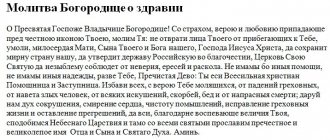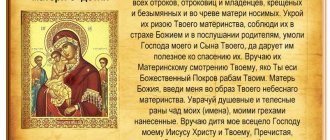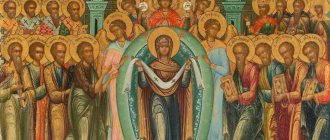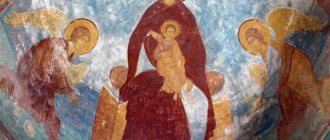Feast of the Annunciation
The song “Rejoice, Virgin Mary” is associated with the Feast of the Annunciation of the Blessed Virgin Mary (April 7, New Style). Evangelist Luke described this event. Archangel Gabriel announced to the Virgin Mary that She would give birth to the Son of God (Gospel of Luke, 1:28-33). “Hail, full of grace: the Lord is with you: blessed are you among women” - this is an angelic greeting. This is the first “good” news for all humanity since the Fall.
Prayer to the Mother of God
“The greeting is majestic but vague; conducive to expecting something miraculous, but no one knows what. The Most Holy Virgin, familiar with the Holy Scriptures, could remember that when the Angel approached Gideon with the greeting: The Lord is with you (Book of Judges of Israel, 6:12), he was preparing him for miraculous deeds and for the salvation of the people of Israel from their enemies” (St. Philaret Drozdov, 1782-1867).
In response to the Virgin Mary’s doubts (according to Gregory of Neocaesarea, fears about the violation of Her virginity), Archangel Gabriel spoke about the mysterious seedless conception. He also said that Mary’s relative, Elisabeth, being of old age, was expecting a child. After all, “with God no word will fail” (Gospel of Luke, 1:37). Seeing God’s will in these words, the Blessed Virgin said in submission: “Behold, the Servant of the Lord; let it be done to me according to your word” (Gospel of Luke 1:38).
“The Incarnation was not only the work of the Father, His Power and His Spirit. But also a matter of the will and faith of the Blessed Virgin. Without the consent of the Immaculate One, without the assistance of Her faith, this plan would have remained unfulfilled, just as without the action of the three Persons of the Divine Trinity Themselves. Only after God has instructed and convinced the Holy Virgin does He accept Her as a Mother and borrow from Her flesh, which She joyfully provides to Him. Just as He was incarnated voluntarily, so it was His will that His Mother would give birth to Him freely and of Her own free will” (Righteous Nicholas Kavasila Hamaeta, 1322-1398).
Login to the site
Virgin Mary, Hail Mary, the Lord is with You: blessed are You among women, and blessed is the fruit of Your womb, for You have given birth to the Savior of our souls. ✿◦.¸¸.◦†◦.¸¸.◦✿◦.¸¸.◦✿◦.¸¸.◦✿◦.¸¸.◦†◦.¸¸.◦✿◦.¸¸.◦✿◦.¸¸.◦✿◦.¸¸.◦†◦.¸¸.◦✿
This prayer is also called the angelic greeting, because it is composed of the words of the Archangel Gabriel, with which he greeted the Blessed Virgin Mary, telling Her about the birth of the Savior from Her. The Holy Virgin Mary is called the Mother of God because Jesus Christ, born of Her, is the eternal God. The word "rejoice" expresses greeting. “Graceful” means filled with the grace and mercy of God. “Blessed are You among women” - worthy of glorification before all women. “Fruit of the womb” is Jesus Christ. “As you gave birth to the Savior of our souls.” With these words we indicate exactly why we glorify the Blessed Virgin Mary - because She gave birth to the Savior of our souls. The prayer is based on the greeting of the Archangel Gabriel to the Virgin Mary at the moment of the Annunciation (Luke 1:28-31; Matt. 1:18-25). The Church really places the mother of Jesus Christ, the Mother of God, above all the saints, above all the angels. Even in the first centuries of Christianity, the prayer “Rejoice, Virgin Mary” appeared, which can be heard in a variety of languages. The famous “Ave, Maria” is the same prayer in Latin. Church hymns say that the Mother of God stands above the Cherubim and Seraphim - the highest ranks of angels
Prayer “Virgin Mother of God, rejoice”
S. Rachmaninov “Theotokos, Virgin...” - choir STSL (Holy Trinity Lavra of St. Sergius)
Performance by the choir of the Academy of Choral Art named after. Popova on tour in Germany. Cologne, Cologne Philharmonic. Conductor Alexey Petrov
Optina Pustyn, monk soloing
women's choir
Many music connoisseurs of all times speak about the high dignity of music and singing and their beneficial influence on people. The Church has a special relationship with singing, which testifies to its heavenly origin.
Even before the creation of man, as soon as the earthly stars appeared on the firmament, all the angels praised the Creator with a great voice (Job 38:7). The Prophet Isaiah saw the Seraphim surrounding the throne of the Lord of Hosts and calling to each other: Holy, Holy, Holy is the Lord of Hosts! The whole earth is full of His glory (Isa. 6:3). The Church of God, through the mouth of King David, proclaims: “Sing to our God, sing, sing to our Kings, sing” (Ps. 46:7).
The Bethlehem shepherds saw many heavenly howls praising God and saying: Glory to God in the highest and on earth peace, good will toward men (Luke 2:13-14). During the Dormition of the Mother of God, the apostles heard wondrous angelic singing.
St. John Chrysostom, reflecting on church singing, writes that nothing so elevates and inspires the soul, does not detach it from the earth, does not deliver it from the bonds of the body, does not incite it to pious meditation and leave all worldly things for a while, as consonant singing and harmonious composed Divine song. He himself was the founder and devoted a lot of effort to creating church choirs. The compilers of church hymns were people who shone with Wisdom, piety and holiness of life, as well as various spiritual gifts.
In the New Testament Church, singing is a necessary element of any public Christian worship. It elevates thought above everything earthly, reconciles us with ourselves and our neighbors, reduces our weaknesses, eases sorrows, and warms our hearts with heavenly love. It was not for nothing that ancient Christians hurried to the temple of God, which bestowed such high spiritual benefits, and were not burdened by the duration of church services, which imparted such a variety of spiritual pleasures to those present in the temple.
Church singing is a special direction in the art of music. Associated with liturgical texts, it acquired a special, unique flavor and absorbed the entire depth of Orthodox dogma. Church singing has existed since the first centuries of Christianity . Of course, it was not systematic and was not as definite in form as it is now, since at that time the liturgical cycle and the Rules had not yet been established. Church singing of the ancient Church was improvisational and free in nature. Basically it was the singing of psalms and hymns. Moreover, in the singing a certain secret unity of the Earthly Church with the Heavenly Church was seen.
Let me remind you that in Catholicism the chant “Hail, Virgin Mary” is known to us as “Ave Maria”.
Ave Maria by the Libera boys
Meeting of the Virgin Mary with Righteous Elizabeth
After several days, the Blessed Virgin Mary went to visit the righteous Elizabeth. She was to give birth to John, the future Baptist of the Lord. Hearing Mary's greeting, baby John began to play joyfully in his mother's womb. Elizabeth herself prophetically said: “Blessed are You among women, and blessed is the fruit of Your womb.”
According to the interpretation of Blessed Theophylact of Bulgaria (11-12 centuries), these words meant that
“The voice of the Virgin was the voice of God incarnate in Her. And therefore He honored the Forerunner with grace while still in the womb and made him a prophet, for the prophetic words of Elizabeth to Mary were not the words of Elizabeth, but of a baby; and the lips of Elizabeth only served him, just as the lips of Mary served the One who was in Her womb - the Son of God. For Elizabeth was then filled with the Spirit, when the child leapt in the womb; if the baby had not jumped, she would not have prophesied. Just as they say about prophets that they first came to a supernatural state and were inspired, and then prophesied, so, perhaps, John, as if inspired, first leaped, then prophesied through the mouth of his mother.”
Song to the Mother of God
The joyful greeting dedicated to the Mother of God was called the Song of the Mother of God. It is used not only in worship services, but also in private prayer. This prayer book is composed of two parts. From the words addressed by the Archangel Gabriel to the Virgin Mary on the day of the Annunciation (Gospel of Luke, 1:28). And from the conversion of righteous Elizabeth, when she was visited by the Blessed Virgin Mary (Gospel of Luke, 1:42).
In its form, the Song of the Mother of God is a festive troparion. It is known that the words of greeting of the Archangel Gabriel have been included in the hymns of the Mother of God since the 5th century. Thus, in the city of Luxor (Egypt) a shard from a clay vessel (6-7 century) was found. It had a Greek text close to the chant “Rejoice, Virgin Mary.”
The Catholic Church also has the Song of the Virgin Mary in Latin. It is called after the first words - “Ave Maria”.
Rejoice to the Virgin Mary: prayer 150 times listen to Optina Pustyn
The prayer to the Virgin Mary, Rejoice, can be heard 150 times daily by the monks of Optina Pustyn, a monastery of the Orthodox Church.
Reading the Angelic (Archangel) greeting to the Queen of Heaven Herself 150 times a day is called the Theotokos rule.
The monks of Optina Pustyn honor the Rule of the Theotokos, read and sing a hymn to the Mother of God.
Veneration of the Virgin Mary the Mother of God, our Intercessor, gives vitality, strengthens faith in God, and fills the soul with grace.
The mercy of the Most Holy Theotokos is limitless, use godly words, turn to prayer with pure thoughts in grief and joy, ask for the help of the Mother of God, God will hear and will definitely help.
Prayer “Rejoice to the Virgin Mary”: history of appearance
Presumably, the author of the composed prayer greeting to the Mother of God is St. Cyril of Alexandria (376-444). The prototype of the chant “Rejoice, Virgin Mary” was the memorial prayer of the liturgy of the Apostle James. Thus, the oldest list of this Liturgy contains the following words:
“Remember, O Lord, the archangel’s voice, saying: Rejoice, full of grace, the Lord is with you, blessed are you among women and blessed is the fruit of your womb.”
Over time, they began to add to these words: “For you gave birth to the Savior of our souls.” At the Liturgy of the Apostle James, the troparion was pronounced by the priest before “Exactly about the Most Holy...”. Now at the liturgy of Basil the Great and John Chrysostom, the prayer “Theotokos, Virgin” is read after the words “Fairly.”
When and how to read
Virgin Mary, rejoice to read better in front of the icon of the Most Holy Theotokos, so that God will hear the prayer. The Mother of God rule says that if you read the words 150 times a day, every day, the reader will receive protection - the protection of the Mother of God.
You can read it forty times, at any free time. If there is not enough time, it is recommended to repeat the words of the text three times.
The main thing is to pray in church in front of icons with faith in your soul, light candles in church or at home, be baptized correctly, and have pure, non-sinful thoughts for the person asking for God’s grace.
When is the Song of the Virgin Mary sung?
Russian Orthodox theologian Mikhail Nikolaevich Skaballanovich (1871-1931) wrote in the Explanatory Typikon:
“The main idea of the song inviting the Mother of God to joy (“Rejoice” in Hebrew and Greek, however, it meant a general greeting, respectively the Latin and Russian “hello”, as this word is conveyed here in the Latin translation), is not without reference to the event of the resurrection, which is why it was adopted exclusively for Sunday and fasting - for other reasons - vespers.”
The chant “Rejoice, Virgin Mary” is sung three times on Sundays and is accompanied by censing. Let us remember that incense is the burning of incense, symbolizing the presence of God and prayers offered to Him. On the day of remembrance of the great saints, the troparion of the saint is first sung twice, and “To the Virgin Mary” once. If the saint is celebrated on a Sunday, then the order is reversed. “To the Virgin Mary” is sung twice, the saint’s troparion is sung once.
Currently, the chant “Rejoice, Virgin Mary” is also used in private prayer. According to the Russian prayer book, it is part of the morning rule, and according to the Greek - the evening rule. The hymn to the Mother of God is contained in the rule of St. Seraphim of Sarov. Also in the rule called “Prayers of Five Numbers”, compiled by St. Demetrius of Rostov. Chanting is the main content of the Theotokos rule. Some Christians sing “Hail, Virgin Mary” along with the Lord’s Prayer before meals.
“Why do we constantly praise, according to the voice and excitement of the Church, the Immaculate Lady Theotokos with dozens of songs and prayers? In order to at least partially give glory to Her greatness, holiness, truth, amazing purity, humility of love for God and for us, unworthy, Her constant intercession for us; in order to know and remember those infinitely great benefits that the Lord poured out through Her on the human race. For through Her we have been vouchsafed to eternally glorify the Holy Life-Giving Trinity, through Her we have been revived and saved by the Trinitarian Divinity. The Mother of God is exalted above the Cherubim and Seraphim and every creature for your salvation and exaltation, Christian, that she saves and covers you” (Righteous John of Kronstadt, 1829-1908).
How does prayer help?
Read the prayer in the following situations:
- to strengthen faith;
- in grief and sadness;
- in despondency;
- before eating;
- on a long and difficult road;
- driving out evil spirits.
The main thing is to remember that you must read the appeal to the Mother of God sincerely and with a pure heart. Under no circumstances should you turn to prayer to wish misfortune on someone or to deceive. The thoughts of the person uttering these godly words must also not be sinful.








